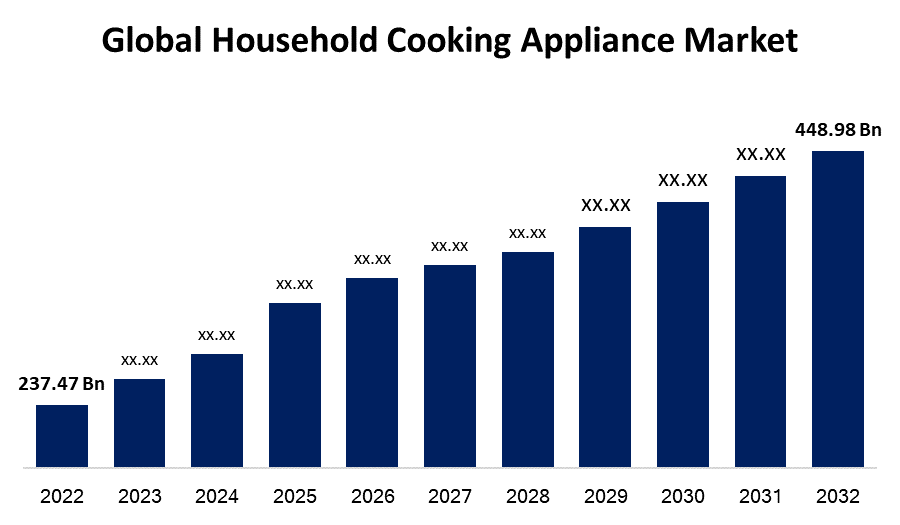Global Household Cooking Appliance Market Size, Share, and COVID-19 Impact Analysis, By Product (Ovens, Cooktops & Cooking Ranges, and Specialized Appliances), By Structure (Built-in, Freestanding), By Distribution Channel (Brick & Mortar, E-commerce), and By Region (North America, Europe, Asia-Pacific, Latin America, Middle East, and Africa), Analysis and Forecast 2022 - 2032
Industry: Consumer GoodsGlobal Household Cooking Appliance Market Insights Forecasts to 2032
- The Global Household Cooking Appliance Market Size was valued at USD 237.47 Billion in 2022.
- The Market Size is Growing at a CAGR of 6.6% from 2022 to 2032
- The Worldwide Household Cooking Appliance Market Size is expected to reach USD 448.98 Billion by 2032
- North America is expected To Grow the fastest during the forecast period .

Get more details on this report -
The Global Household Cooking Appliance Market Size is anticipated to exceed USD 448.98 Billion by 2032, Growing at a CAGR of 6.6% from 2022 to 2032.
Changing nutritional habits, a growing number of nuclear families, and an increasing percentage of employed women and self-employed individuals provide numerous expansion opportunities. Furthermore, stringent energy efficiency laws in different countries, easy access to household appliances on e-commerce platforms, and the continuous introduction of innovative cooking items are expected to drive further market growth.
Market Overview
Household cooking appliances are appliances that are used in every family's home to make cooking easier for everyone. Cooking is nearly impossible without these appliances for cooking. There are numerous kitchen appliances that can operate on either gas or electricity. Extreme caution is required before investing in kitchen appliances for the home. Quality, cost, and energy savings should never be overlooked.
The growing need to automate cooking and reduce human intervention has resulted in numerous advancements in household cooking appliances. As a result, in order to persuade household consumers to switch from traditional to modern cooking appliances, manufacturers typically retain the original mechanisms while incorporating the most recent technologies into the modern appliance. The demand for these cooking items is also increasing, as some people have begun to pursue cooking as a hobby and are subsequently purchasing the most recent machines.
The market for sophisticated kitchen electronic gadgets has increased in the last few years, owing to an increased need for appliances that can reduce cooking time and minimize food preparation problems. Consumers' hectic schedules, particularly among the urban and working classes, are projected to support the growth of the global market for household cooking appliances during the forecast period.
Report Coverage
This research report categorizes the market for the global household cooking appliance market based on various segments and regions and forecasts revenue growth and analyzes trends in each submarket. The report analyses the key growth drivers, opportunities, and challenges influencing the household cooking appliance market. Recent market developments and competitive strategies such as expansion, product launch, and development, partnership, merger, and acquisition have been included to draw the competitive landscape in the market. The report strategically identifies and profiles the key market players and analyses their core competencies in each sub-segment of the household cooking appliance market.
Global Household Cooking Appliance Market Report Coverage
| Report Coverage | Details |
|---|---|
| Base Year: | 2022 |
| Market Size in 2022: | USD 237.47 Billion |
| Forecast Period: | 2022-2032 |
| Forecast Period CAGR 2022-2032 : | 6.6% |
| 2032 Value Projection: | USD 448.98 Billion |
| Historical Data for: | 2018-2021 |
| No. of Pages: | 200 |
| Tables, Charts & Figures: | 100 |
| Segments covered: | By Product, By Structure, By Distribution, By Region. |
| Companies covered:: | Electrolux AB, GE Appliances, Haier Group, Koninklijke Philips N.V., LG Electronics, Robert Bosch GmbH, Samsung, Smeg S.p.A, Whirlpool Corporation, Winiadaewoo Co. Ltd., Panasonic Corporation, Thermador, Others. |
| Pitfalls & Challenges: | COVID-19 Empact, Challenge, Future, Growth, & Analysis |
Get more details on this report -
Driving Factors
Smart kitchen appliances are widely used in many developed countries, including the United States, Canada, Japan, and Germany. The use of artificial intelligence (AI) and the Internet of Things (IoT) to access and control various smart kitchen appliances via mobile or remote devices has recently gained popularity. Several companies have begun to incorporate these cutting-edge technologies into their smart cooking appliances in order to reap the benefits.
Increased living standards, increased disposable income, and rising demand for high-end devices are expected to keep the market growing over the projection period. Furthermore, consistent growth in the variety of available cooktops, such as electric, gas, induction, coil, and smooth surface, is predicted to boost the market growth. The availability of high-end features on improved wall ovens and ranges is additionally projected to boost demand.
Restraining Factors
The high initial cost of conventional cooking appliances is projected to stymie market expansion. Modern appliances necessitate extensive maintenance, which limits the usage of advanced culinary gadgets. This factor is impeding market expansion.
The growing number of single people who prefer eating out to cooking at home is influencing product demand. Furthermore, the global expansion of the food and catering industries is likely to limit the market growth of residential cooking appliances.
Market Segmentation
The Global Household Cooking Appliance Market share is classified into product, structure, and distribution channel.
- The cooktops & cooking ranges segment is expected to hold the largest share of the global household cooking appliance market during the forecast period.
The global household cooking appliance market is categorized by product into ovens, cooktops & cooking ranges, and specialized appliances. Among these, the cooktops & cooking ranges segment is expected to hold the largest share of the global household cooking appliance market during the forecast period. The latest generation of cooktops and cooking ranges for homes are available in a variety of sizes, are simple to install, and have user-friendly features. As a result, they have enhanced consumer appeal and opened up new economic opportunities, particularly in North America and Europe. Cooktops and gas, electric, and induction appliance ranges are differentiated in this category. Induction cooktops with digital temperature control panels save time and energy. As a result, induction cooktops are more popular among modern households.
- The freestanding segment dominated the global household cooking appliance market in 2022.
Based on the structure, the global household cooking appliance market is divided into built-in and freestanding. Among these, the freestanding segment dominated the global household cooking appliance market in 2022, and will likely to continue its dominance over the forecast period. Cleaning and maintaining freestanding household devices is uncomplicated, resulting in significant growth for the market during the predicted period. Freestanding appliances are more affordable than their built-in counterparts, and spare parts are easily available. Freestanding household appliances are adaptable in terms of placement because they are easily relocated and can be placed anywhere.
- The E-commerce segment is expected to grow at the highest pace in the global household cooking appliance market during the forecast period.
The global household cooking appliance market is divided by distribution channel into brick & mortar and E-commerce. Among these, the E-commerce segment is expected to grow at the highest pace in the global household cooking appliance market during the forecast period. The growth can be attributed to its associated features which include a faster purchasing process, discounts and offers, easy price and product comparison, stock availability, easy exchange options, and product flexibility. Most manufacturers have launched e-commerce websites in response to the growing popularity of Internet commerce. E-commerce has surpassed traditional establishments in popularity and is anticipated to dominate the sector in the future years.
Regional Segment Analysis of the Global Household Cooking Appliance Market
- North America (U.S., Canada, Mexico)
- Europe (Germany, France, U.K., Italy, Spain, Rest of Europe)
- Asia-Pacific (China, Japan, India, Rest of APAC)
- South America (Brazil and the Rest of South America)
- The Middle East and Africa (UAE, South Africa, Rest of MEA)
Asia Pacific is anticipated to hold the largest share of the global household cooking appliance market over the predicted timeframe.

Get more details on this report -
Asia Pacific is projected to hold the largest share of the global household cooking appliance market over the predicted years. The availability of raw resources at competitive pricing and cheap labor costs are driving the expansion. As a result, the region has become a major hub for producers of household kitchen appliances. As a result, several corporations from other regions have increased their operations in Asia Pacific. Continued urbanization, changing lifestyles, increased consumer buying power, and early adoption of breakthrough technologies are all projected to contribute to the growth of the regional market.
North America is expected to grow at the fastest pace in the global household cooking appliance market during the forecast period. The United States and Canada are the major contributors to the North American region in the household cooking appliance market. As high-speed data networks and modular kitchens continue to be deployed, IoT-enabled appliances will likely grow more popular. Household buyers in the area are increasingly opting for multi-functional cooking ovens due to their high prices. The market's major players are constantly upgrading their product lines with cutting-edge technology. Furthermore, they invest heavily in research and development to produce advanced products through the integration of the Internet of Things (IoT) and Artificial Intelligence (AI).
Competitive Analysis:
The report offers the appropriate analysis of the key organizations/companies involved within the global household cooking appliance along with a comparative evaluation primarily based on their product offering, business overviews, geographic presence, enterprise strategies, segment market share, and SWOT analysis. The report also provides an elaborative analysis focusing on the current news and developments of the companies, which includes product development, innovations, joint ventures, partnerships, mergers & acquisitions, strategic alliances, and others. This allows for the evaluation of the overall competition within the market.
List of Key Companies
- Electrolux AB
- GE Appliances
- Haier Group
- Koninklijke Philips N.V.
- LG Electronics
- Robert Bosch GmbH
- Samsung
- Smeg S.p.A
- Whirlpool Corporation
- Winiadaewoo Co. Ltd.
- Panasonic Corporation
- Thermador
- Others
Key Target Audience
- Market Players
- Investors
- End-users
- Government Authorities
- Consulting And Research Firm
- Venture capitalists
- Value-Added Resellers (VARs)
Recent Developments
- In February 2023, Prizer-Painter Stove Works, Inc. introduced a 36-inch hob with a 'Power Boost' function. The newly released hob has an improved temperature control capability and approximately twelve cooking settings.
- In January 2023, At CES 2023, Samsung announced a portfolio of customisable Bespoke smart appliances. The business unveiled the Bespoke AI Oven with touch controls and a seven-inch screen during this unveiling. The oven may be linked to Samsung Health to track diet and fitness statistics.
- In January 2023, GE Appliances introduced 14 new induction cooktops under various brand names. The company has included innovative features such as precision temperature control, which allows consumers to regulate the degree of the burner for optimum performance and consistency, with this introduction.
Market Segment
This study forecasts revenue at global, regional, and country levels from 2020 to 2032. Spherical Insights has segmented the Global Household Cooking Appliance Market based on the below-mentioned segments:
Global Household Cooking Appliance Market, By Product
- Ovens
- Cooktops & Cooking Ranges
- Specialized Appliances
Global Household Cooking Appliance Market, By Structure
- Built-in
- Freestanding
Global Household Cooking Appliance Market, By Distribution Channel
- Brick & Mortar
- E-commerce
Global Household Cooking Appliance Market, By Region
- North America
- US
- Canada
- Mexico
- Europe
- Germany
- Uk
- France
- Italy
- Spain
- Russia
- Rest of Europe
- Asia Pacific
- China
- Japan
- India
- South Korea
- Australia
- Rest of Asia Pacific
- South America
- Brazil
- Argentina
- Rest of South America
- Middle East & Africa
- UAE
- Saudi Arabia
- Qatar
- South Africa
Rest of Middle East & Africa
Need help to buy this report?